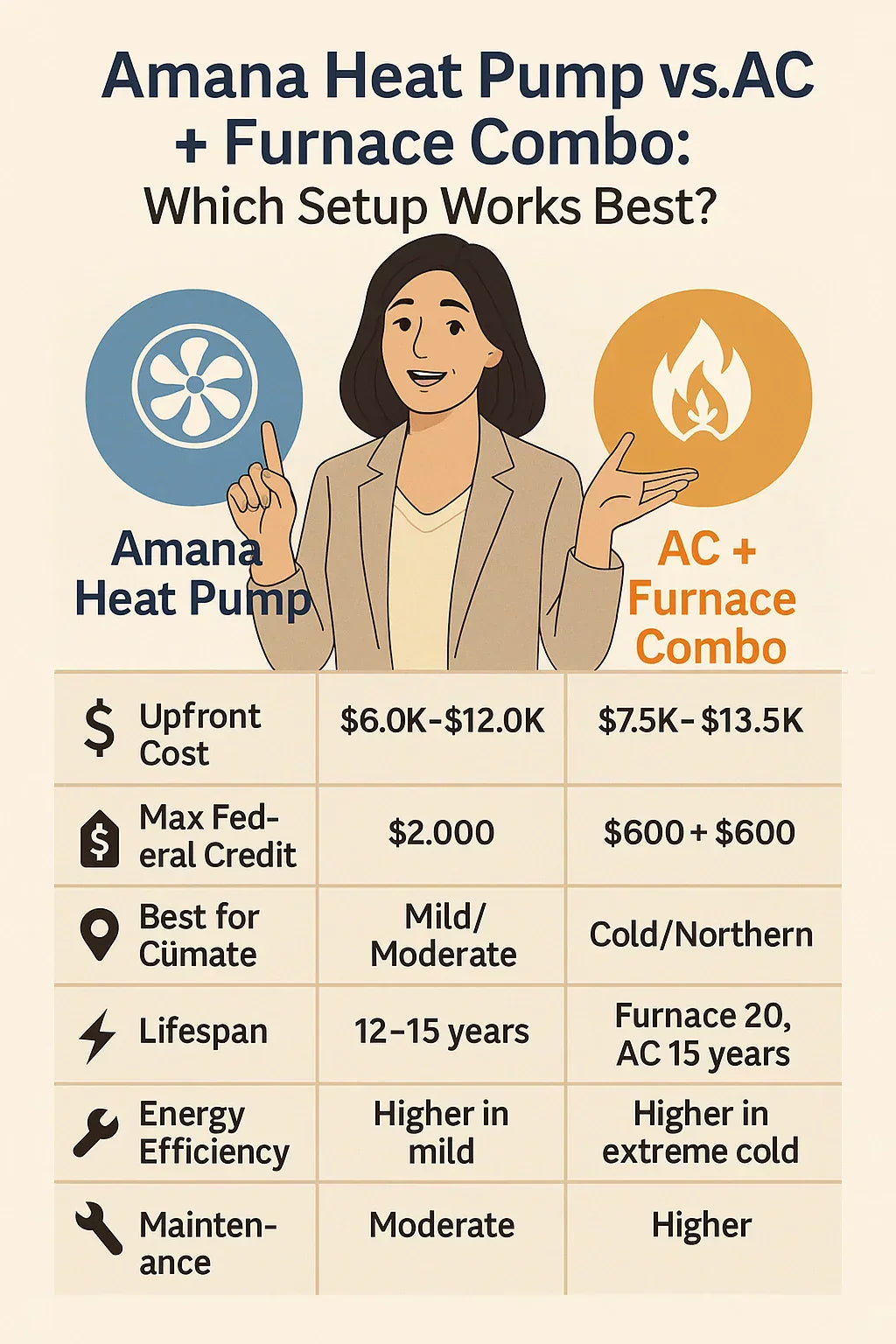Like many homeowners in 2025, I want a reliable HVAC system that balances comfort, efficiency, and cost savings. But when I started shopping, I quickly realized I had a big decision to make:
➡️ Should I go with an Amana heat pump that handles both heating and cooling, or stick with the more traditional AC + furnace combo?
If you’re asking the same question, you’re in the right place. Let’s break it down step by step.
🌀 1. How Each System Works
🔵 Amana Heat Pump
Think of a heat pump as an all-in-one climate control system. Instead of burning fuel, it moves heat:
-
In summer: pulls heat out of your home and moves it outside.
-
In winter: extracts heat from the air (even cold air) and transfers it indoors.
Key Amana Models in 2025:
-
ASZC16 (two-stage, up to 16 SEER2)
-
AVZC20 (variable-speed inverter, up to 21 SEER2, ENERGY STAR certified)
🟠 AC + Furnace Combo
This setup uses two separate systems:
-
Air Conditioner (like Amana’s ASXC16) for summer cooling.
-
Gas or Electric Furnace (like Amana’s AMEC97) for winter heating.
Pros: excellent heating power in frigid climates.
Cons: higher upfront costs and more equipment to maintain.
👉 Learn more about how heat pumps work
💲 2. Upfront Costs
One of my first questions was: Which setup is more affordable to install in 2025?
📊 Average Installed Cost Ranges
| System Type | Equipment | Install & Labor | Total 2025 Range |
|---|---|---|---|
| Amana Heat Pump | $4,500–$7,500 | $2,000–$4,500 | $6,000–$12,000 |
| AC + Furnace Combo | $5,500–$8,000 | $2,000–$5,500 | $7,500–$13,500 |
👉 According to HVAC.com, heat pumps often cost less than buying a separate furnace and AC.
⚡ 3. Energy Efficiency & Utility Bills
Efficiency is where heat pumps really shine—at least in the right climate.
🔵 Heat Pumps
-
SEER2 (cooling): Up to 21 with Amana AVZC20.
-
HSPF2 (heating): High ratings mean lower electric bills.
-
Best in moderate climates with winter lows above ~25°F.
🟠 AC + Furnace Combos
-
Furnaces with 97% AFUE convert nearly all fuel into heat.
-
Stronger performance in cold northern climates, where heat pumps lose efficiency.
-
Gas bills may rise in harsh winters.
🌍 4. Climate Considerations
Savvy tip: Your zip code matters more than you think.
-
Southern U.S. & Coastal States:
Heat pumps save the most money, since winters are mild. -
Midwest & Northern States:
Furnace combos remain king for dependable heating. -
Hybrid/Dual-Fuel Systems:
Amana’s dual-fuel setups automatically switch between electric heat pump and gas furnace depending on outside temperatures.
👉 Energy Star Climate Guidance
🛠️ 5. Maintenance & Lifespan
🔵 Heat Pump
-
Lifespan: 12–15 years
-
Maintenance: Twice-yearly servicing recommended (spring + fall).
🟠 AC + Furnace Combo
-
Furnace lifespan: 15–20 years
-
AC lifespan: ~12–15 years
-
More components = higher maintenance over time.
Cost note: furnace repairs can run $400–$1,200, while major AC compressor replacement may cost $1,800–$3,000 (The Spruce).
🏷️ 6. Incentives & Rebates in 2025
💰 Federal Tax Credits
Under the Inflation Reduction Act (IRA), homeowners can save big:
-
Heat Pumps: Up to $2,000 credit
-
High-Efficiency AC Units: Up to $600
-
High-Efficiency Furnaces: Up to $600
-
Annual Household Cap: $3,200
👉 IRS Energy Efficient Home Improvement Credit
🏦 State & Utility Rebates
Heat pumps often qualify for $1,000–$2,000 rebates from utilities, while furnaces typically see smaller incentives.
👉 Check local rebates with Energy Star’s Rebate Finder
📊 7. Cost & Comfort Comparison Chart
| Feature | Amana Heat Pump | AC + Furnace Combo |
|---|---|---|
| Upfront Cost | $6K–$12K | $7.5K–$13.5K |
| Federal Credit (Max) | $2,000 | $600 + $600 |
| Best Climate Fit | Mild/Moderate | Cold/Northern |
| Lifespan | 12–15 years | Furnace 20 yrs, AC 15 yrs |
| Efficiency Savings | High in mild | High in extreme cold |
| Maintenance | Moderate | Higher (two systems) |
📉 8. Mistakes Savvy Avoids
-
❌ Buying a heat pump in a sub-zero climate without backup.
-
❌ Ignoring ductwork—poor ducts = wasted efficiency.
-
❌ Missing out on rebates by choosing the wrong SEER2 rating.
-
❌ Not registering Amana’s lifetime warranty (within 60 days).
💡 9. Savvy’s Pro Tips for Choosing
-
✅ Check local climate data before deciding.
-
✅ Compare lifetime energy costs, not just installation price.
-
✅ Ask contractors about dual-fuel Amana options for mixed climates.
-
✅ Use rebates and tax credits to reduce net cost.
-
✅ Schedule installations in spring/fall for better pricing and availability.
🧮 10. Real-Life Example
Savvy’s cousin upgraded her northern home in 2024:
-
Choice: AC + AMEC97 Furnace
-
Cost: $11,000 installed
-
Federal Credits: $600 (furnace) + $600 (AC)
-
Local Utility Rebate: $800
-
Net Cost: $9,000
-
Result: Reliable heat during -5°F winters, bills ~$150/month lower than old system.
Meanwhile, Savvy’s neighbor in Georgia installed an Amana AVZC20 Heat Pump:
-
Cost: $10,500 installed
-
Federal Credit: $2,000
-
Utility Rebate: $1,200
-
Net Cost: $7,300
-
Result: Bills dropped 40%, year-round comfort with one system.
🎯 Conclusion: Savvy’s Bottom Line
So, which setup works best?
-
If you live in a moderate climate, an Amana heat pump is the clear winner—eligible for big rebates, cheaper to run, and provides both heating and cooling in one system.
-
If you’re in a cold northern region, an AC + furnace combo still delivers the most reliable winter comfort.
-
And for those who want the best of both worlds, Amana’s dual-fuel systems offer flexibility.
For Savvy, the decision isn’t just about today’s price—it’s about comfort, efficiency, and savings for the next 15+ years.
In the next topic we will know more about: DIY-Friendly or Pro Install Only? What You Need to Know About Installing Amana Systems







